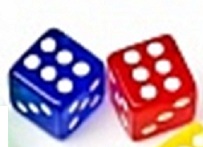Example Question:
Suppose you are offered 10 to 4 odds that you cannot roll two even numbers with the roll of two fair six-sided dice. In other words, you will win $10 if you succeed (and roll two even values) and you will lose (pay) $4 if you fail to roll two even values. What is the expected value of this game? What is the expected value if you play 400 times?
Solution and Explanation:
Here you are rolling two fair dice (6 sided) and you are looking for two even numbers.
Here are all the Possibilities:
2, 2
2, 4,
2, 6
4, 2
4, 4
4, 6
6, 2
6, 4
6, 6
So there are 9 possible ways for this to happen.
When rolling two fair dice, you can get any of 6 outcomes on die1 and any of 6 outcomes on die 2. So the sample space (all possibilities) has 36 values.
This means your chance of rolling two even values is 9/36 Therefore, the probability of winning is 9/36 = .25
Probability of losing is 1 – .25 = .75
The expected value is the prob of winning * the value you get when you win + prob of losing* value you lose (which is negative as it is a loss).
Expected Value = .25 * $10 + .75*(-$4) ==> Notice that the $4 is negative because it is a loss
= .25*10 – .75*4 = 2.50 – 3 = – .50
The expected value in this example in negative which tells us that over time (as you play) you are expected, on average, to be at a loss at the end. The more you play, the more you are likely to lose.
Overall if you play 400 times your expected win/loss is: 400* (-.50) = – $200
This is a loss of 200 dollars.
NOTE: in some cases, the result will be positive and will allow an overall gain over time. Try this problem again but using $20 if you win and -$3 if you lose. In that case, you expected value will be positive and therefore the more you play, the more you expect to win.

